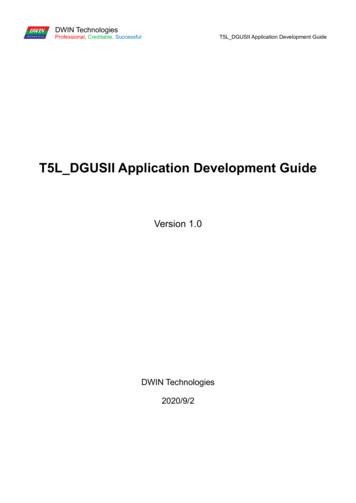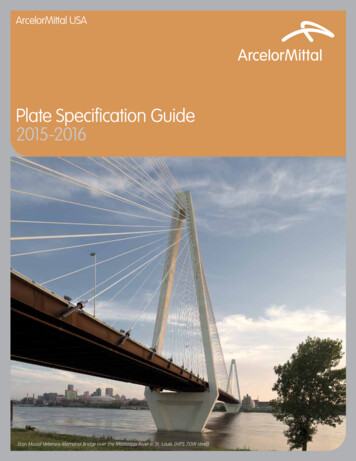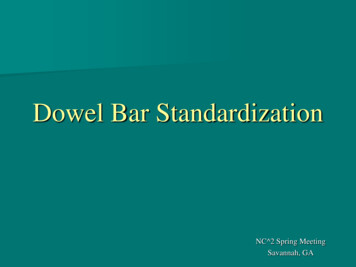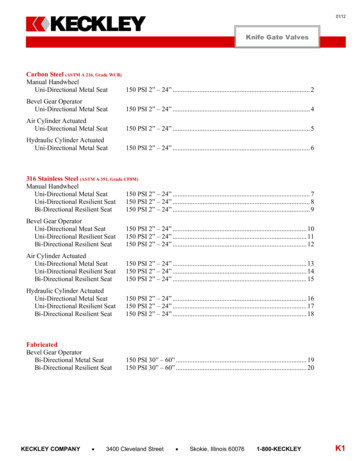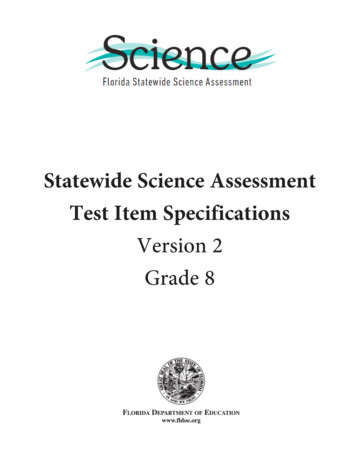
Transcription
Statewide Science AssessmentTest Item SpecificationsVersion 2Grade 8
Copyright Statement for This Office of Assessment PublicationAuthorization for reproduction of this document is hereby granted to persons acting in an official capacitywithin the Uniform System of Public K–12 Schools as defined in Section 1000.01(4), Florida Statutes. Thecopyright notice at the bottom of this page must be included in all copies.All trademarks and trade names found in this publication are the property of their respective owners andare not associated with the publishers of this publication.Permission is NOT granted for distribution or reproduction outside of the Uniform System of Public K–12Florida Schools or for commercial distribution of the copyrighted materials without written authorizationfrom the Florida Department of Education. Questions regarding use of these copyrighted materials shouldbe sent to the following:The AdministratorOffice of AssessmentFlorida Department of EducationTallahassee, Florida 32399-0400Copyright 2012State of FloridaDepartment of State
TABLEOFCONTENTS1IntroductionOrigin and Purpose of the SpecificationsScope of this DocumentOverall ConsiderationsItem Contexts (Scenarios)4Criteria for Statewide Science Assessment Test ItemsUse of GraphicsItem Style and FormatScope of Test ItemsGuidelines for Item Writers11Cognitive Complexity of Statewide Science Assessment Test ItemsItem DifficultyCognitive ComplexityUniversal Design18Review Procedures for Statewide Science Assessment Test ItemsReview for Potential Bias and Community SensitivityReview of Test Items19Guide to the Individual Benchmark SpecificationsBenchmark Classification SystemDefinitions of Benchmark SpecificationsGrades 3–5 Science Benchmarks34Individual Benchmark Specifications for Statewide Science Assessment Grade 8A–1Appendix A: Directions for Item Review and Statewide Science Assessment ItemRating FormB–1Appendix B: Science Content Assessed by Statewide Science Assessment Grade 8C–1Appendix C: Statewide Science Assessment Item Writer Glossary, Grades 5 and 8D–1Appendix D: Reporting Categories for Statewide Science Assessments and Biology1 End-of-Course AssessmentE–1Appendix E: Statewide Science Assessments and Biology 1 End-of-CourseAssessment Test Design SummaryF–1Appendix F: Periodic Table of the Elements, Statewide Science Assessment Grade 8and Biology 1 End-of-Course AssessmentStatewide Science Assessment Test Item Specifications Version 2, Grade 8Florida Department of Education i
ii Statewide Science Assessment Test Item Specifications Version 2, Grade 8Florida Department of Education
INTRODUCTIONIn recent years, two realities focused attention on the need to reevaluate Florida’s SunshineState Standards. First, in 2005, outside consultants reviewed the 1996 Sunshine StateStandards and suggested that the benchmark language offer greater specificity to indicateclearly what teachers should teach and what students should be able to do. Second, federallegislation through the No Child Left Behind Act of 2001 (NCLB) holds schools and schooldistricts accountable for how well each child is learning, which further emphasizes the needto hone expectations for all students.In January 2006, the Florida Department of Education (FDOE) committed to a six-year cycleof review and revision of the K–12 content standards. The science standards were rewritten,and the Next Generation Sunshine State Standards (NGSSS) for science were adoptedby the Florida State Board of Education in February 2008 (available online dardSearch.aspx).For grades K–8, the NGSSS are divided into benchmarks that identify what a studentshould know and be able to do at each grade level. This document, Statewide ScienceAssessment Test Item Specifications Version 2, Grade 8 (Specifications), providesinformation about the benchmarks, the stimulus types, and the test items designed toassess the standards for grades 6–8.The Statewide Science Assessments measure achievement of grade 5 and grade 8 Floridastudents in science. The Biology 1 End-Of-Course (EOC) Assessment measures achievementof Florida students enrolled in Biology 1, or an equivalent course, by assessing studentprogress on benchmarks from the NGSSS that are assigned to the Biology 1 course.Origin and Purpose of the SpecificationsThe Florida Department of Education and committees of experienced Florida educatorsdeveloped and approved the Specifications. The Specifications is a resource that definesthe content and format of the test and test items for item writers and reviewers. Thegrade-level Specifications indicates the alignment of test items with the NGSSS. It alsoserves to provide all stakeholders with information about the format and function of theStatewide Science Assessments.Scope of this DocumentThe Specifications for grade 8 provides general and grade-specific guidelines for thedevelopment of all test items used in the Statewide Science Assessment test for grade 8. Twoadditional Specifications documents provide the same information for the Statewide ScienceAssessment grade 5 and the Biology 1 EOC assessment.The Overall Considerations section in this Introduction provides an explanation of thescience concepts assessed by the test. The Criteria for Statewide Science AssessmentTest Items section addresses cognitive-complexity levels as well as the review processesused to ensure the quality of the stimuli and test items. The same section explains thegeneral guidelines for selection and development of multiple-choice items. The IndividualBenchmark Specifications section contains specific information about each benchmark.This section provides benchmark clarification statements, content limits, stimulus attributes,response attributes, prior knowledge, and a sample item for each benchmark grouping.Statewide Science Assessment Test Item Specifications Version 2, Grade 8Florida Department of Education 1
Overall ConsiderationsThis section of the Specifications describes the guidelines that apply to all test itemsdeveloped for the Statewide Science Assessment for grade 5 and grade 8.Overall considerations are broad item-development issues that should be addressed duringthe development of test items. Sections of Criteria for Statewide Science AssessmentTest Items relate more specifically to one aspect of the development (e.g., content limits,stimulus attributes).1. Each test item should be written to measure primarily one benchmark;however, other benchmarks may also be reflected in the item context(scenario).2. Some benchmarks are combined for assessment. The individual specificationand Appendix B indicate which benchmarks are combined. Test items maybe written to “also assesses” benchmarks; however, the overall theme of thebenchmark grouping should be evident in the items.3. Test items should be appropriate for students in terms of grade-levelinstruction, experience and difficulty, cognitive development, and readinglevel. The reading level of the test items should be on grade level, except forspecifically assessed science terms or concepts. The Individual BenchmarkSpecifications and the grade 8 Item Writer Glossary found in Appendix Cprovide information to the writer on which science terms are appropriate foruse in test items at grade 8. For grade 8, words found in the benchmarks andthe glossary are appropriate for use in test items unless otherwise noted in theSpecifications. The grade 5 glossary is provided as a reference of the terms andconcepts that are appropriate for grade 5. Knowledge of the terms in the grade5 glossary is assumed.4. Test items should assess the application of the concept rather than thememorization of science fact, law, or theory unless otherwise noted in theIndividual Benchmark Specifications.5. Test items will not require the student to define terms.6. Test items that include a collection of data should require the student toanalyze or interpret that data (e.g., use data from a scenario to identify atrend) rather than retrieve information directly from a passage, chart, graph,or table.7. Test items or illustrations for grades 5 and 8 may use the following commonelementary laboratory tools: balance, battery, beaker, compass, eyedropper,flashlight, globe, graduated cylinder, light bulb, magnet, magnifying glass orhand lens, metric measuring tape, metric ruler, microscope, microscope slide,mirror, model, safety goggles, spring scales, stopwatch, streak plate, telescope,test tube, thermometer, topographic map, and tuning fork.8. Test items or illustrations for grade 8 may use the following common middleschool laboratory tools in addition to the elementary laboratory tools:dissection equipment, electronic balance, flask, hot plate, meter stick, petridish, pH sensors, pipette, prism, probe, pulley, test strips, and triple-beambalance.2 Statewide Science Assessment Test Item Specifications Version 2, Grade 8Florida Department of Education
9. Test items referring to technologies familiar to elementary and middle-schoolstudents may include computers and computer models (simulations).10. Test items will not require the creation of a chart, graph, or table.11. At grade 5, all test items should be written in a conceptual nature. Grade 5 testitems should not require the use of a calculator. At grade 8, students are allowedto use a four-function calculator, although test items should not require its use.12. Test items may require the student to apply knowledge of the science conceptsdescribed in the prior knowledge benchmarks from lower grades; however,that knowledge should NOT be assessed in isolation.13. Each test item should be written clearly and unambiguously to elicit thedesired response.14. Test items will not require the memorization of equations or formulas unlessotherwise noted in the Individual Benchmark Specifications. A reference sheetis not provided to students. If equations or formulas are needed, they must beincluded in the test item.15. Test items will not require memorization of the periodic table. For grade 8, aperiodic table is provided to the students and is also found in Appendix F.16. Test items should not disadvantage or exhibit disrespect to anyone in regard toage, gender, race, ethnicity, language, religion, socioeconomic status, disability,occupation, or geographic region.Item Contexts (Scenarios)The context in which a test item is presented is called the item context or scenario. Testitems should be placed in a context.1. The test item context should be designed to interest students at the assessedgrade level. Scenarios should be appropriate for students in terms of gradelevel experience and difficulty, cognitive development, and reading level.2. The context should be directly related to the question asked. The contextshould lead the student cognitively to the question. Every effort should bemade to keep test items as concise as possible without losing cognitive flow ormissing the overall idea or concept.3. Item contexts should not refer to students using textbooks or the Internetas resources. Item contexts should focus on the students engaging in sciencelearning rather than reading about science. Item contexts should avoid using asimple classroom scenario.4. Item contexts and illustrations depicting individuals conducting laboratoryinvestigations should include proper safety equipment and model safelaboratory procedures.5. Scenarios describing scientific investigations should model current sciencemethodology and adhere to the Intel International Science and EngineeringFair Rules and Guidelines unless otherwise noted in the benchmarkclarification statements. These rules and guidelines can be found using theDocument Library link at http://www.societyforscience.org/ISEF.6. The test item content should be timely and not likely to become dated.Statewide Science Assessment Test Item Specifications Version 2, Grade 8Florida Department of Education 3
CRITERIAFORSTATEWIDE SCIENCE ASSESSMENT TEST ITEMSAll Statewide Science Assessment test items are in multiple-choice (MC) format. The generalspecifications on pages 4 through 17 cover the following criteria for the Statewide ScienceAssessment: Use of GraphicsItem Style and FormatScope of Test ItemsGuidelines for Item WritersItem DifficultyCognitive Complexity of Statewide Science Assessment Test ItemsUniversal DesignUse of GraphicsGraphics are used to provide both necessary and supplemental information––that is, somegraphics contain information that is necessary for answering the question, while other graphicsillustrate or support the context of the question. Scenarios may include diagrams, illustrations,charts, or tables, unless otherwise noted in the Individual Benchmark Specifications.1. Test items should not begin with art. Art in test items is always preceded by text.2. All tables, charts, and graphs should be titled. Titles should be in all caps,boldfaced, and centered.3. Illustrations and pictures are either titled or introduced. If a title is used, thetitle shall be set in boldface with initial caps and may be placed above orbelow the illustration or picture.4. Whenever possible, the components of graphics should be labeled.Item Style and FormatThis section presents stylistic guidelines and formatting directions that should be followedwhile developing test items.General Guidelines1. Test items should be clear and concise and should use vocabulary and sentencestructure appropriate for the assessed grade level. Writers should refer to theresources provided during item writer training and to the Glossary in the backof the Specifications to determine if the language used in the test item is gradelevel appropriate.2. Whenever possible, test items should be written in active voice rather than inpassive voice.3. Scientific concepts should be grade appropriate. Writers should refer to thePrior Knowledge information in the Individual Benchmark Specificationssection, the instructional foundation for each benchmark grouping. For grade8, the grades 3–5 benchmarks are found on pages 22–33.4. Test items should have only one correct answer. The words most likely or bestshould only be used when appropriate to the question.5. The final sentence of all test item stems must be expressed as a question.4 Statewide Science Assessment Test Item Specifications Version 2, Grade 8Florida Department of Education
6. At grade 5, test items addressing temperature should use degrees Celsius withthe approximate whole number equivalent in degrees Fahrenheit, e.g., 37 C(99 F). At grade 8, temperatures should be given in degrees Celsius unlessotherwise noted in the Individual Benchmark Specifications.7. Metric units of measure should be used in scenarios addressing mass, length,weight, and/or volume. International System of Units (SI) should be usedunless otherwise noted in the Individual Benchmark Specifications.8. Test items requiring art should be to scale whenever possible. If needed forclarity, a not-to-scale text box should be included at the bottom left of the art.In items with graphics as answer options, the stem may contain the statement“Options are not to scale.” This will avoid repetitive placement of the not-to scale box with each option.9. Graphics in test items should be clearly labeled and contain all necessaryinformation.10. Test items referring to new developments or discoveries should include phrasessimilar to according to current knowledge or based on current knowledge.11. Test item questions using the word not should emphasize the word not usingall uppercase letters (e.g., Which of the following is NOT an example of . . . ).12. As appropriate, boldface type should be used to emphasize key words in thetest item question (e.g., least, most, greatest, percent, best).13. Masculine pronouns should NOT be used to refer to both sexes. Name(s)should be used whenever possible to avoid gender-specific pronouns (e.g.,instead of The student will make changes so that he . . . use John and Maria willmake changes so that they . . . ).14. An equal balance of male and female names should be used, including namesrepresenting current student names and different ethnic groups appropriate forFlorida.15. Grade 8 test items may express values using scientific notation; however, testitems should not require calculations involving scientific notation. Use ofscientific notation is not appropriate at grade 5.16. Decimal numbers between 21 and 1 should have a leading zero.17. SI units should be expressed in a single type of unit when possible(e.g., 1.4 kilograms instead of 1 kilogram 400 grams).18. Decimal notation should be used for numbers with SI units (e.g., 1.5 gramsinstead of 1 1 grams).219. Commas should be used in numbers greater than or equal to 1,000 except fornumbers having an SI unit. In this case, numbers with four digits should bepresented without a comma or a space (e.g., 9960 meters). Numbers with morethan four digits should be presented with a thin space inserted in place of acomma (e.g., 10 123 kilograms).Statewide Science Assessment Test Item Specifications Version 2, Grade 8Florida Department of Education 5
20. The first occurrence of units of measure should be written out in the test itemstem, e.g., kilograms (kg). In graphics, an abbreviation may be used (e.g., g orcm). To avoid confusion between the preposition in and the abbreviation forinches, only units of measure in graphics should be presented, e.g., height (cm)NOT height (in cm).21. In titles of tables and charts and in labels for axes, the unit of measure shouldbe included, preferably in lowercase and in parentheses, e.g., height (m).22. In most cases, scenarios involving elements, chemical formulas, or chemicalsymbols and/or equations should be written out followed by the abbreviation,e.g., carbon dioxide (CO2).23. Test items assessing concepts that require equations should include theequation with the test item unless otherwise noted in the Individual BenchmarkSpecifications. Test items will not require the memorization of formulas.24. In the item stem, values needed to compute answers should be presented asnumerals.Multiple-Choice (MC) Items1. MC items should take approximately one minute per item to answer.2. MC items are worth one point each.3. MC items should have four answer options (A, B, C, D or F, G, H, I foralternating items).4. The correct response should be indicated.5. The rationale for distractors (incorrect answer choices) should be indicated.The rationale should include information explaining why a student wouldselect that distractor.6. Distractor rationales should represent computational or conceptual errorscommonly made by students who have not mastered the assessed concepts.7. Each distractor should be a believable answer for someone who does not reallyknow the correct answer.8. Whenever possible, distractors should include common sciencemisconceptions.9. All distractors should be written in a style appropriate to the question asked.For example, a “how” question should have distractors that explain how.10. Paired comparison structure of options should be avoided.11. Options should have parallel structure whenever possible. Test item optionsshould not have an outlier (e.g., an answer option that is significantly longerthan or different from the other options).12. Test items should not be clued or answered by information in the stem orother options.13. Options such as none of the above, all of the above, not here, not enoughinformation, or cannot be determined should not be used. These responsesshould not be used as distractor rationales.6 Statewide Science Assessment Test Item Specifications Version 2, Grade 8Florida Department of Education
14. If an option is a single word or a phrase, the option should start witha lowercase letter. If an option is a sentence, the sentence should beconventionally capitalized and punctuated. Options that are imperativesshould be treated as sentences.15. In most cases, answer options should be arranged vertically beneath the item stem.16. If four graphics are labeled horizontally or vertically and horizontally, theoption labeling should be as follows:A. B. C. D.orA. C.B. D.17. If the answer options for a test item are strictly numerical, they should bearranged in ascending or descending order, with the place values of digitsaligned. When the test item requires the identification of a choice from theitem stem, table, chart, or illustration, the options should be arranged as theyare presented in the item stem, table, chart, or illustration.18. If the answer options for a test item are neither strictly numerical nordenominate numbers, the options should be arranged by the logic presented inthe test item, by alphabetical order, or by length. Options may also be orderedin reverse alphabetical order or from longest to shortest. Answers that are oneword in length should be in alphabetical or reverse alphabetical order.Context-Dependent Item SetsContext-dependent (CD) item sets are groups of test items that are written to a commonstimulus. The stimulus provides a basis for testing student understanding of scienceconcepts or processes, critical thinking, or problem solving.1. The stimulus for the CD set may be a short passage describing a scientificevent or investigation. The stimulus may include illustrations, graphics, tables,and/or graphs.2. As a general rule, the stimulus content should focus primarily on two scienceareas from the NGSSS (Nature of Science, Earth and Space Science, LifeScience, or Physical Science).3. The reading level of the stimulus, excluding science terms, should be on gradelevel.4. Test items will be written so that students with benchmark mastery usescientific knowledge and the information in the passage to answer the testitems in the set.5. Test items will not be clued or answered by information in the passage orother test items in the CD set.6. Test items may require the student to analyze, interpret, evaluate, and/or drawinferences from the information in the stimulus.7. As many test items as possible should be written to the stimulus. Those testitems should represent an appropriate variety of benchmarks. On a test, aminimum of two different benchmarks should be assessed in the CD set.8. CD sets may be titled; however, titles are not required.Statewide Science Assessment Test Item Specifications Version 2, Grade 8Florida Department of Education 7
The following CD set is provided as an example of three items written to a commonstimulus.The Indian River LagoonAn estuary is a body of water in which fresh water draining from the land mixes withsalt water from the ocean. The result of this mixture is an environment with abundantplant and animal life. The Indian River Lagoon is a 156-mile-long estuary on Florida’seast coast. It is a diverse estuary, supporting thousands of species of plants and animals.The food web and food pyramid shown below are examples of the relationships thatexist in the Indian River Lagoon ecosystem.EgretFlounderClam wormCrabPhytoplanktonHeronInsectsSea grassSeaweedFood WebEgretFlounderClam wormnot to scale8PhytoplanktonFood Pyramid Statewide Science Assessment Test Item Specifications Version 2, Grade 8Florida Department of Education
Which of the following has the largest population in the Indian River Lagoon ecosystem?A.B.C. D.crabegretfloundersea grassWhich of the following statements most accurately describes the energy transfer between thelevels of the food pyramid in the Indian River Lagoon?A.B. C.D.Energy stays in the phytoplankton at the lowest level.Energy is released into the environment only from the egret.Energy travels up from the phytoplankton to the clam worm.Energy moves from the flounder to both the clam worm and egret.In the Indian River Lagoon ecosystem, many organisms compete with one another for foodsources. Which organism in the food web competes with the egret for food?A.B.C. D.clam wormcrabflounderheronStatewide Science Assessment Test Item Specifications Version 2, Grade 8Florida Department of Education 9
Scope of Test ItemsThe scope of Statewide Science Assessment test items for grades 6–8 is presented inAppendix B. The benchmarks serve as the objectives to which the test items are written.Additional guidelines or restrictions are located in the Individual Benchmark Specifications.Guidelines for Item WritersStatewide Science Assessment item writers must have a comprehensive knowledge of theassessed science curriculum and a strong understanding of the scientific concepts andcognitive abilities of the students taking the test. Item writers should know and consistentlyapply the guidelines established in this Specifications document, as well as contribute to thegoal of developing test content that allows students to perform at their best. Item writersare also expected to use their best judgment in writing test items that measure the sciencebenchmarks of the NGSSS without introducing extraneous elements that reflect bias for oragainst a group of students.Item writers for the Statewide Science Assessment must submit test items in a particularformat and must include the following information about each test item. Because testitems are rated by committees of Florida educators following submission to the FDOE,familiarity with the directions for rating test items (found in Appendix A) would proveuseful to all item writers.FormatItem writers must submit test items in the agreed-upon template.All appropriate sections of the template should be completedbefore the test items are submitted.SourcesItem writers are expected to provide sources for all verifiableinformation included in the test item. Acceptable sources includescience magazines, science journals, or Internet sites maintainedby reputable organizations such as government agencies,universities, or research centers.CorrectResponseItem writers must supply the correct response. Each distractorshould be a believable answer for someone who does not knowthe correct answer. Rationales must include an explanation ofwhy a student would choose a certain distractor.Submissionof ItemsWhen submitting test items, item writers must balance severalfactors. Test item submissions should: be written to the appropriate cognitive complexity;be written to the appropriate content focus;include the content source for the test items;have a balance in location of the correct answer withinbenchmarks; have a balance of different female and different male names; use names representative of elementary and middle-schoolstudents in Florida; and be scientifically accurate.10 Statewide Science Assessment Test Item Specifications Version 2, Grade 8Florida Department of Education
COGNITIVE COMPLEXITY OFSTATEWIDE SCIENCE ASSESSMENT TEST ITEMSEducational standards and assessments can be aligned based on the category of contentcovered and also on the complexity of knowledge required. The Statewide ScienceAssessment test items, while assessing Florida’s NGSSS, must also reflect this goaland standard. It is important to develop test items that elicit student responses thatdemonstrate the complexity of knowledge and skills required to meet these objectives. Thedegree of challenge of Statewide Science Assessment items is currently categorized in twoways: item difficulty and cognitive complexity.Item DifficultyAfter a test item appears on a test, item difficulty refers to the actual percentage ofstudents who chose the correct answer. The classification scheme used for item difficulty isbased on the following:EasyMore than 70 percent of the students are likely to respond correctly.AverageBetween 40 percent and 70 percent of the students are likely torespond correctly.ChallengingLess than 40 percent of the students are likely to respond correctly.Statewide Science Assessment Test Item Specifications Version 2, Grade 8Florida Department of Education 11
Cognitive ComplexityCognitive complexity refers to the cognitive demand associated with a test item. Thecognitive classification system implemented by the FDOE is based upon Dr. Norman L.Webb’s Depth of Knowledge (DOK) levels.1 The rationale for classifying a test item by itsDOK level of complexity focuses on the expectations made of the test item, not on the abilityof the student. When classifying a test item’s demands on thinking (i.e., what the test itemrequires the student to recall, understand, analyze, and do), it is assumed that the student isfamiliar with the basic concepts of the task. Test items are chosen for the Statewide ScienceAssessment based on the NGSSS and their grade-level appropriateness, but the complexityof the test items remains independent of the particular curriculum a student has experienced.On any given assessment, the cognitive complexity of a multiple-choice item may be affectedby the distractors (answer options). The cognitive complexity of a test item depends on thegrade level of the assessment; a test item that has a high level of cognitive complexity at onegrade may not be as complex at a higher grade.The categories—low complexity, moderate complexity, and high complexity—form anordered description of the demands a test item may make on a student. For example,low-complexity test items may require a student to solve a one-step problem. Moderatecomplexity test items may require multiple steps. However, the number of steps is notalways indicative of cognitive level. High-complexity test items may require a studentto analyze and synthesize information. The distinctions made in item complexity ensurethat test items will assess the depth of student knowledge at each benchmark. The intentof the item writer weighs heavily in determining the complexity of a test item. The threeStatewide Science Assessment test items that follow illustrate how a single concept may beassessed by test items with increasing cognitive complexity.The pages that follow illustrate some of the varyin
Science Content Assessed by Statewide Science Assessment Grade 8 C–1 Appendix C: Statewide Science Assessment Item Writer Glossary, Grades 5 and 8 D–1 Appendix D: Reporting Categories for Statewide Science Assessments and Biology 1 End-of-Course Assessment E–1 Appendix E: Statewide





